1936 & 2016…Convention Coverage Eerily Similar For NBC & CBS
1936 & 2016…Convention Coverage Eerily Similar For NBC & CBS
Believe it or not, the Republicans held their convention in Cleveland in mid June of 1936, and the Democrats held theirs in Philadelphia in late July. Sound familiar?
http://fadedsignals.com/post/147634247368/from-1936-the-nbc-radio-facilities-at-the
In Cleveland, Alf Landon was the GOP candidate selected, and Franklin Roosevelt was the democrats choice in Philly. At the link is a very nice image of NBC Radio’s operational lay out of the 53 microphone setup in Cleveland for their Red and Blue Networks. Be sure to click on the image for a bigger-better look.
Below is a soon to be legend in reporting, Robert Trout, in Cleveland with a new CBS portable microwave unit with the antenna in the cane, and a wrist watch microphone.
As a side note, FDR won in the biggest landslide vote in US history. Wonder how it will play out this time around? Thanks to NBC’s Brian Durr for the link and story idea. -Bobby Ellerbee
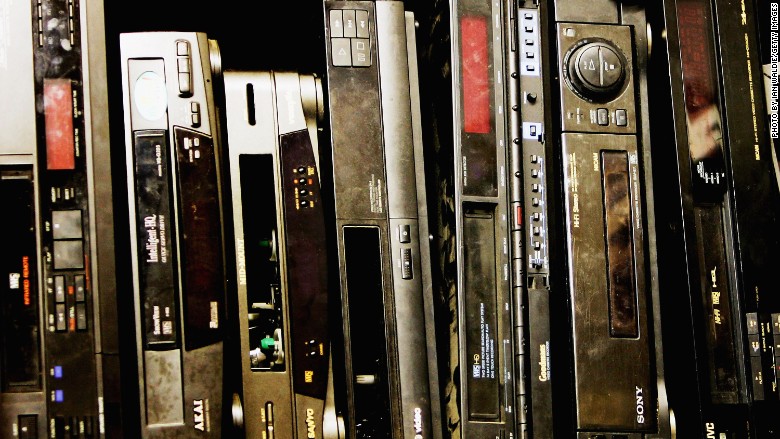

The last VCR will be manufactured this month
Remembering The VCR…RIP, The End Is Near
The last VCR will be manufactured this month
R.I.P., VCR. Funai Electric, the world’s last known VCR manufacturer, will cease production of video-cassette recorders this month.
Rare Color Film…5 “Colgate Comedy Hour” Stars At El Capitan
Rare Color Film…5 “Colgate Comedy Hour” Stars At El Capitan
At the link, you will see Eddie Cantor, Bud Abbott & Lou Costello and Dean Martin & Jerry Lewis arriving at NBC’s El Capitan Theater in Hollywood in 1953.
This is a short, but sweet color home movie shot on the south side of the theater, as they arrive for rehearsal. Because the hosts rotated on a weekly basis, it would be rare for all of them to be there at the same time, but I looks like that may have been the case.
In the film, you can see the stairs pictured below. If the building looks familiar, in ’63, ABC took over the lease and called this, The Hollywood Palace.
The El Capitan is at 1735 North Vine Street, just a couple of blocks north of where NBC’s Radio City West was located, and was NBC’s first “spill-over” location for television once AT&T linked the coast with the rest of the country in 1951.
On April 1, 1951 the El Capitan Theatre was leased to NBC for fifteen years at a cost of $30,500 per year. On Sunday, September 30, 1951, “The Colgate Comedy Hour” became NBC’s first regularly scheduled west-to-east television broadcast, and it came from The El Capitan, on a bi-weekly basis, with the other weeks done in New York. Thanks to our friend Rick Scheckman for sharing this clip. Enjoy! -Bobby Ellerbee
You Mean They Used Color Cameras For B/W Broadcasts?
You Mean They Used Color Cameras For B/W Broadcasts?
Yes, they did and WICU was not alone…so did WSB in Atlanta, and many other local stations in the mid ’60s.
This photo is one I recently found, and it reminded me of a the disbelief many young people had on an article I did here, a year or so back on the conundrum that the ’65 network color conversions had caused at the local level.
From ’65 till about ’67, RCA’s booth at the NAB had the TK60 B/W camera next to their TK42 color camera, and lot of local stations were struggling to decide how to handle local color.
Many had just plopped down a hefty sum for a new color transmitter and support equipment, but what was next? How long could they hedge their bets on local B/W?
To add to the problem, the TK42 was not as good a camera as the TK41, and most knew it, but RCA didn’t have a fix yet. They had discontinued the TK41 in 1964, and the TK44 didn’t come till ’68. On top of that, Norelco’s PC60 came to the market in ’65, and CBS was all over that, and ordered them by the dozens, crowding out local orders.
Back then, sometime the best idea was to buy a color camera and use it without the colorburst on two + camera shows. I know it is hard to believe, but believe your eyes…it happened. -Bobby Ellerbee
Exclusive! Soupy Sales Returns To WXYZ, Detroit For A Visit!
Exclusive! Soupy Sales Returns To WXYZ, Detroit For A Visit!
Thanks to Barry Mitchell, here is a 1982 video of Soupy returning to where it all started…WXYZ TV in Detroit. Good tales from old timers and some of the tricks they pulled on each other, plus a few pies in the face. Enjoy and share! -Bobby Ellerbee
July 17, 1955…Behind The Scenes With ABC At Disneyland Opening
July 17, 1955…Behind The Scenes With ABC At Disneyland Opening
This is the only place you can see this rare 14 minute video of ABC’s preparations for the 29 camera live remote, of the 90 minute opening ceremony show at Disneyland. 61 years ago today, what was then television’s largest remote took place at the Disneyland Grand Opening. Here is the behind the scenes film produced by ABC to commemorate the massive 29 camera, live broadcast.
The video above ends with the narrator saying “And here’s the show”. Below is the full 90 minute program, hosted by Art Linkletter, Walt Disney and many more famous faces.
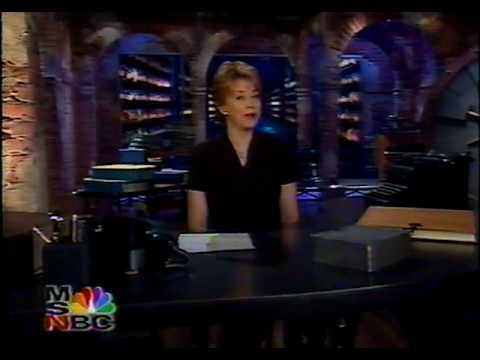

20 Years Ago…MSNBC Launched On Cable & Internet
20 Years Ago…MSNBC Launched On Cable & Internet
This video may, or may not start at 1:24, which is the first few minutes of the debut, but if not, the three promos for the new network before it are worth a watch too. The stories and events they will be covering are remarkably similar to the ones we are watching today…the political conventions, the upcoming Atlanta Olympics, Russia’s president, and more, as reported from some very young looking “old friends”.
MSNBC launched July 15, 1996 on the already existing NBC owned cable channel, America’s Talking, using space at CNBC’s Ft. Lee facility. They later got their own building in Secaucus, but have been in Studio 3A at 30 Rock since October 2007, with several new set renovations this year. One of those was the addition of Brian Williams breaking news desk, and here’s link to a site that has this, and several other stories on NBC studio makeovers. http://www.newscaststudio.com/2015/09/24/brian-williams-breaking-news-desk-debuts-on-msnbc/
One of the fist MSNBC series is one that I love, and wish someone would bring back…”Time And Again”. Using NBC archival footage, that show is one of the best historical retrospective series I’ve seen.
Click this link to see some of the people, shows and subjects they covered and see for yourself. Happy Birthday MSNBC! -Bobby Ellerbee
And so it began. On 15 July 1996, the U.S. gained a new 24 hour news channel which was then a joint venture between NBC News and Microsoft. For some hours le…
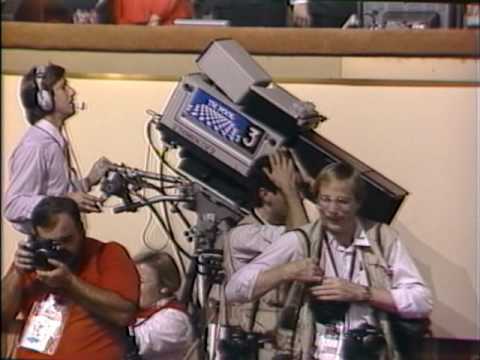

See Anyone You Know? 1984 Pool Cameramen Shoot Each Other
See Anyone You Know? 1984 Pool Cameramen Shoot Each Other
With the Republican National Convention coming next week, here’s a look back at the very end of the 1984 version, when Thomson cameras were in vogue at CBS. At 3:35, I see our friend Charlie Huntley. This video came from producer Phil Savenick, who has a great collection of early television memorabilia, including rare tubes once owned by Philo Farnsworth. Thanks for sharing Phil. Enjoy! -Bobby Ellerbee
Here are the cameramen from the 1984 Repubican convention photographing each other as the pool video ran out. A nice document of TV history.


July 14, 1933…Popeye Comes To The Silver Screen
July 14, 1933…Popeye Comes To The Silver Screen
This is the first of 109 cartoons Popeye starred in from 1933 until 1942. Newspaper cartoonist E. C. Segar is the man who created Popeye, but before he came along, Olive Oyl had been the star of his “Thimble Theater” comic strip, and had been since the strip debuted December 19, 1919…10 years before Popeye was created on January 17, 1929. The sailor man was an instant hit and Segar’s creation character became one of the top funny paper characters in the country.
When Popeye came to the silver screen, he needed a voice and for the first two years, that was done by Billy Costello, but he was replaced in 1935 by Jack Mercer. Olive Oyl was originally voiced by none other than the voice of Betty Boop, May Questel, but when producer Max Fleischer moved operations to Miami from New York in 1938, Questel didn’t want to move, so Margie Hines took over. In 1943, Paramount moved the operation back to New York and May Questel once again became the voice of Olive.
William Pennell was the original voice of Bluto, but he too declined to move to Florida, but when Paramount moved the operation back to NYC, he took over again. While they were in Miami, Gus Wickie was the voice of Bluto.
Thanks to the animated shorts, Popeye became even more of a sensation than he had been in comic strips. As Betty Boop gradually declined in quality as a result of Hays Code (movie sex police) enforcement in 1934, Popeye became the studio’s star character. By 1936, Popeye began to sell more tickets and became the most popular cartoon character in the country in the 1930s…beating Mickey Mouse. Well blow me down! -Bobby Ellerbee
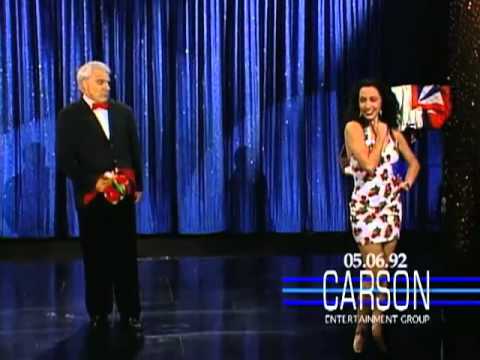

Forgotten Gem! Steve Martin’s “The Great Flydini” Sketch…CLASSIC!
Forgotten Gem! Steve Martin’s “The Great Flydini” Sketch…CLASSIC!
That “wild and crazy guy”, Steve Martin, has done so much great work, for so long, it’s easy to have missed some of his sketches. Even though I am a big fan, I had not seen this till recently. This is one of the best pieces of comedy I’ve ever seen, and I hope you’ll enjoy this as much as I do. -Bobby Ellerbee
http://www.thebeamreport.com
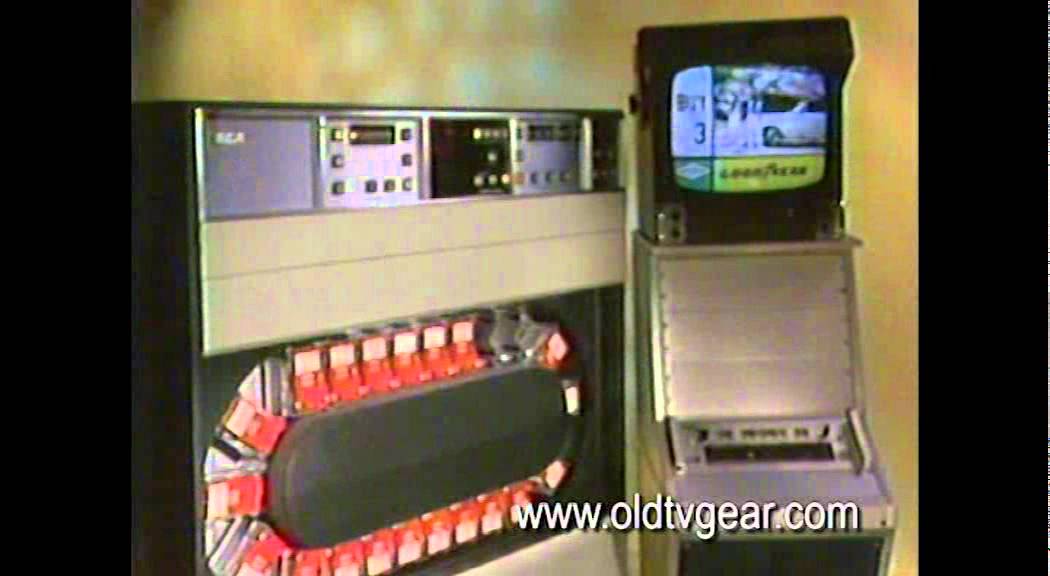

RCA TCR-100 Videotape Cartridge System, Sales Reel
July 1970…The RCA TCR 100 Video Cart System Debuted
Some loved it, some hated it, but this was a real innovation, and came a full 2 years before the Ampex ACR 25. Thanks to Barry Mitchell for the reminder. -Bobby Ellerbee


‘Squidbillies’ Is Still Blazing a Caustic, Backwoods Trail
My Show…”Squidbillies” Season 10 Debuts Tonight!
For those of you that don’t know, I am the voice of The Sheriff on the “Squidbillies” which has been the top rated show on Adult Swim since we started in 2006. (FYI: at night, Cartoon Network becomes Adult Swim).
It is rare for my character to not be in an episode, but tonight, Sheriff and I will be at my house watching the wild, and crazy shenanigans the New York Times attributes to us, with great pride.
It’ll be fun night in Dougal County, Georgia ya’ll. Congratulations to all my fellow voice mates, our producers, artists and sound engineers on 10 great years, and thanks for inviting me on this trip!
-Bobby Ellerbee
‘Squidbillies’ Is Still Blazing a Caustic, Backwoods Trail
The Adult Swim series returns for a 10th season, and lipstick will never be the same, while “Duck Dynasty,” on A&E, lacks spontaneity.
July 10, 1950…The Original, TV Music Countdown Show Debuts “Your Hit Parade”…
July 10, 1950…The Original, TV Music Countdown Show Debuts
“Your Hit Parade” was television’s first ever Top Ten type music show, and radio’s too. It started on the NBC Red Network on April 20, 1935 and ran there till 1955. The television version started on NBC on this day in 1950 and ran there till ’58 when it went to CBS for a year.
In the great photo below, we see one of the show’s biggest stars, Dorothy Collins singing before the cameras at NBC’s Ziegfeld Theater, in color. The show started July 10, 1950 in NBC’s brand new Studio 6A which was converted from radio to TV on May 29, 1950.
The show needed more floor space for the 10 song scene sets, and the next year it moved to NBC’s brand new 8H which was converted to television on January 30, 1950. The show was done in color occasionally from The Colonial Theater, but went all color in 1956 when it moved to Perry Como’s new home at the Ziegfeld Theater. As a side note, the 4 RCA TK41s at the Zeigfeld were sent to Studio 8H when that beacame the “Peacock Studio” in 1963.
TeleTales: “Film At 11″… WPIX Coined The Phrase In 1948
TeleTales: “Film At 11″… WPIX Coined The Phrase In 1948
“First on the scene. First on the screen”. That was the motto for NYC’s newest television station, WPIX, which went on the air June 15, 1948. It was owned by the New York Daily News, which was famous for their pictures, thus the name PIX, and the video arm was just as determined to be a leader in their film and visuals.
At the time, WCBS, WNBT and WABD all ran their newscasts in the early evenings, and all signed off before 11 PM. In order to add some extra time for viewers to catch the news, and (aha!) have their set tuned to WPIX the next day, when it was turned on, they ran their WPIX Telepix Newsreel program at 7:30 PM and again at 11 PM.
Two days later, a United DC 6 passenger plane went down in Mt. Carmel PA. The NYDN had a plane, and WPIX film cameras went along to get the first footage and pictures for the late edition of the paper, and the 11 o’clock newscast.
That evening, June 17, 1948, WPIX announcers reminded the viewing public that soon, they would see the first images of the incident, and ended each mention with “film at 11”. This also added punch to the fact the WPIX was Channel 11.
For years, WPIX was the only NYC station to run an 11 o’clock news cast, and was the first TV station in the US to do this. There can be no doubt that “film at 11” was born then and there. Below is the NYDN front page from sign on day. Enjoy and share! -Bobby Ellerbee
Mystery Photo Reveals…THE FIRST WNBC TV Was NOT In New York!?!
Mystery Photo Reveals…THE FIRST WNBC TV Was NOT In New York!?!
Believe it or not, there was another WNBC TV, before there was WNBC New York!
Yesterday, our friend Barry Mitchell sent this to me and I was as bewildered as he was, so I started digging. How could these famous call letters be on the side of this TK11 with a Channel 30 designation? WNBC New York is Channel 4.
Well, as it turns out, before NBC’s flagship station took the WNBC calls in 1960, the network bought its first, and only UHF station in New Britain, Connecticut and named it…WNBC. Who knew?
That was 1956, and at the time New York was WRCA (’54-’60), and of course, had started as WNBT (’41-’54). Today, that first WNBC TV is WVIT, but when NBC bought it, it was WKNB, which went on the air in 1954 on UHF Channel 30.
UFH was barely receivable back then, but with RCA as a maker of all things television, I suppose they bought it more to play with and test than anything else, but it was not a very successful venture. NBC was out by 1959, and fortunately, took these glorious calls with them and plugged them in the next year in the Big Apple.
I had no idea this had ever happened, and you never know where opportunities to find out these kind of things will pop up. If you have some mystery photos like this, share them with us and let’s see what we can find out. Below is a link to more on the WVIT history. Thanks Barry! Enjoy and share! -Bobby Ellerbee
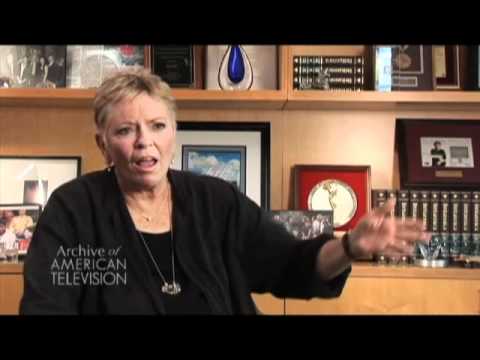

July 5, 1982…”NBC News Overnight” Debuts
July 5, 1982…”NBC News Overnight” Debuts
https://www.youtube.com/watch?v=yFTw6LFuclE Video 1
#t=37″ target=”_blank”>https://www.youtube.com/watch?v=cKBMuyZFmhQ #t=37 Video 2
Many have called this “the best written, best executed news program ever produced”. I agree…I watched it every night. Before I get too far along, at the first link above, Linda Ellerbee talks about Overnight in the same style that endeared her to so many. The second video is the last few minutes on the air and the full 60+ staff and crew credits with video of all of them! You may see some familiar faces!
‘NBC News Overnight’, a live one-hour news program, aired from 1:30 till 2:30 AM for about seventeen months starting on July 5, 1982. Its debut coincided with a lunar eclipse, and despite science reporter Robert Bizel’s disappearance during the live broadcast (he went for some coffee), it was a success from the first night.
It never talked down to its viewers because, from day one, it never assumed that the lowest common denominator was the way to go. Entirely the opposite, in fact. The writing was crisp, witty, and smart. Overnight closed its doors in the first week of December 1983, after NBC management dropped it because of low ratings.
The first co-anchors, co-writers, and co-editors for Overnight were Linda Ellerbee and Lloyd Dobyns, who had, a few years previously, co-written and co-hosted Weekend, an offbeat weekly magazine for NBC.
After about six months of helping to shape Overnight, Dobyns left to do other work for NBC. Bill Schechner ably took his place as co-anchor and co-writer until ‘Overnight’ went off the air.
Overnight featured literary quotations, subtitled reports from overseas news programs for a new perspective, the best features (or sometimes just the silliest) from local affiliates, and a whole grab bag of things never before seen on national news programs. As Bill Schechner said on the final program, it proved that there is more than one way to deliver and to receive the news. Overnight must have been puzzling to some, though, because it had an unexpected mix of both seriousness about important issues and irreverence for nonsense.
As with any live broadcast, goofs occurred from time to time on the program. However, the anchors always made the best of it. They would chuckle instead of becoming mortified and simply corrected their mistakes, often injecting a bit of humor. Ellerbee once said this on the program after one such mistake:
“Live TV is a great time saver. It allows you to make a fool of yourself in front of large groups of people instead of one at a time.”
Shortly after Dobyns left, an NBC News executive suggested to Ellerbee that she take Lloyd’s seat now that she was the senior anchor. Ellerbee said she felt no need for that, but agreed to give it a try. Some nights later, she returned to her old spot. During that broadcast, she explained, after showing a tape of her position changes:
“Lately, you may have noticed a bit of musical chairs being played on this program. But in three nights, I have spilled three cups of coffee because the coffee was where it should be, but I was not. So I have moved back. And if the executives don’t like it, they may jolly well come and do the show and spill their own coffee.”
A year and a half after its birth, NBC decided to cancel Overnight in November 1983, due to low late night ratings and corresponding lack of ad revenue. In the following days and weeks, thousands of viewers (ten thousand, to be exact) called and wrote letters or telegrams of protest to NBC management. Some even sent checks and cash to defray the costs of producing the program (all the money was returned).
NBC’s news release on the program’s cancellation said the program remained “the model of a one-hour news program,” but it was being canceled because “being the best is not enough”. And so it goes!
By the way, Linda is a distant cousin of mine through marriage. Even if she wasn’t related, I would still think she’s still one of the best and most unique in the business! Enjoy and share! -Bobby Ellerbee
See the full interview at http://www.emmytvlegends.org/interviews/people/linda-ellerbee


Remembering Noel Neill…Superman’s Lois Lane Is Gone
Remembering Noel Neill…Superman’s Lois Lane Is Gone
Actress Noel Neill, the First Lois Lane of the Screen, Dies at 95
She starred as the intrepid Daily Planet newspaper reporter in 1948 and ’50 movie serials and in TV’s ‘Adventures of Superman.’
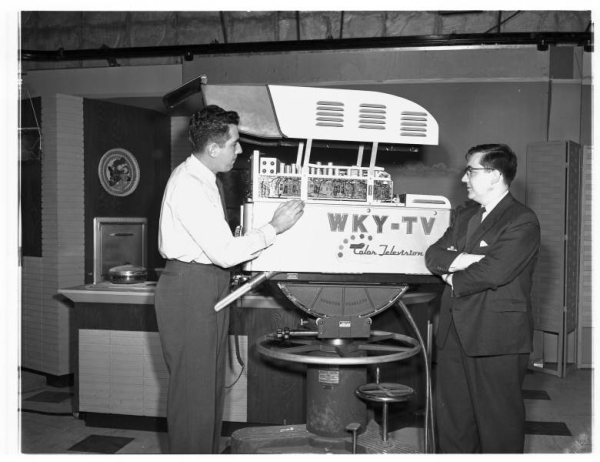

WKY-TV: First In Local Live Color
In this piece, you’ll see television history in the making that starts in 1949 and continues into the present. Now standing safely in Boston is one of the first two color cameras ever delivered to a local station: WKY-TV in Oklahoma City.
The Black and White Years / The Color Years / The Rescue of the Historic TK40

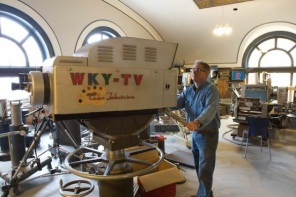
After a brief introduction, you’ll see a large part of this station’s unique story, told in more than 80 photos.
It truly amazes me how stations that are not in major markets take some of the biggest risks and make some of the biggest breakthroughs. Take, for instance, Oklahoma City in 1949. That’s when WKY (now KFOR) became Oklahoma’s first TV station.
This station reminds me of the people at WGAL in Lancaster, Pa. who started about the same time and built a big station in the nation’s smallest TV market, but had the vision to buy first-class equipment and produced a first-class product. Just look below at the Sanner crane and Houston Fearless Panoram dolly with TK10s and TK30s mounted on them. WKY-TV was intent on being the best.

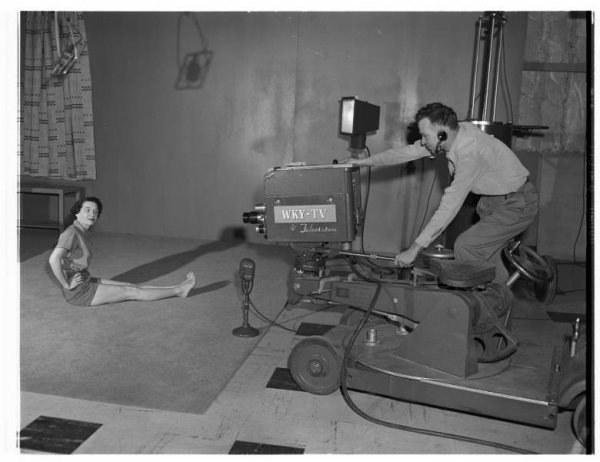
In 1954, WKY would be the first local station in the country to receive a pair of RCA TK40 color cameras, even before the NBC O&O stations had them. Only NBC and CBS network studios had TK40s prior to WKY, but more on that below.
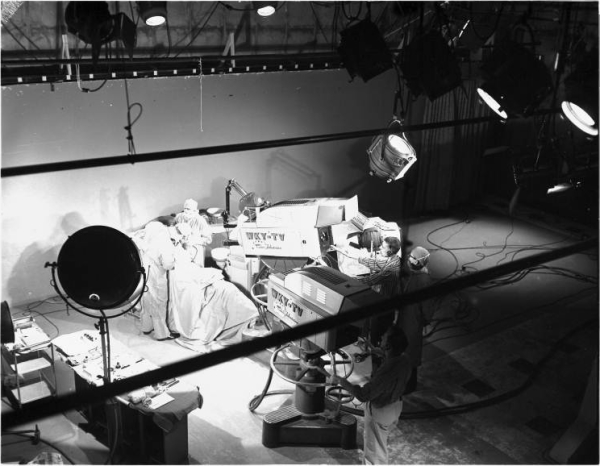
And in the big box below, it’s nothing short of a brand-new Ampex VR 1000!
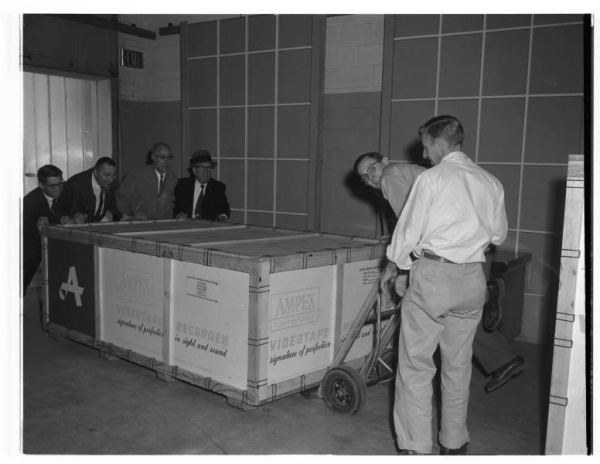
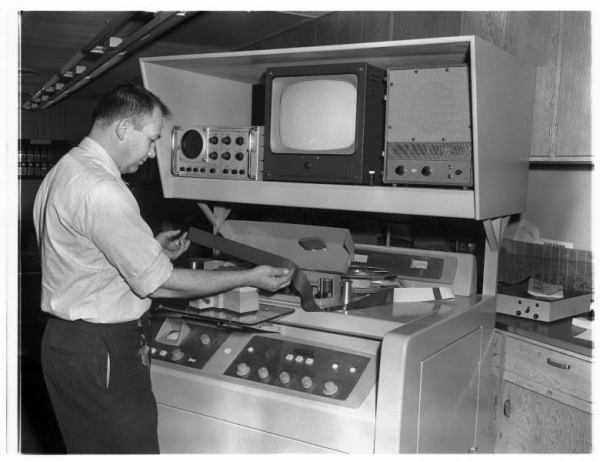
There are so many images that I can’t caption and comment on them all, so I’m just going to lay them out below in a few sections that show the Black and White and then the Color Years, and then…SOMETHING SPECIAL! You’ll see one of these historic WKY TK40 cameras as it sits today and see the story on its rescue.
But, first…let me share what I think is a universal truth, and we see it in the image below. It is my humble opinion that for some reason, the young tall guys always get to carry the light stuff and the older, short guys always wind up with the heavy stuff.
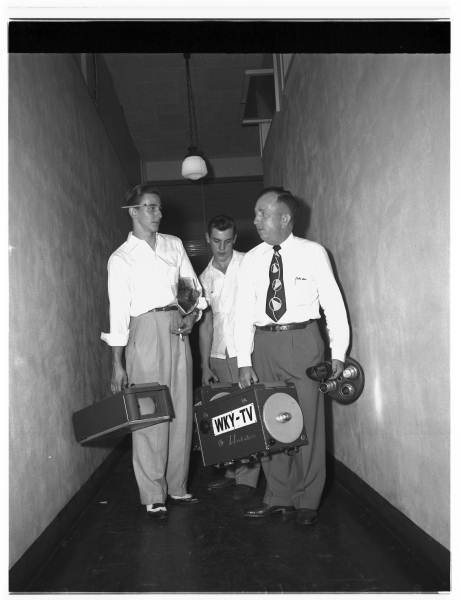
The Black and White Years
Below you’ll see more than three dozen RCA TK10s and TK30s in action, and a couple of shots of the WKY control room.
If you are wondering what Ed Sullivan is doing at what is now a NBC affiliate, remember that early on, local stations didn’t have to be bound to a single network and could carry shows of their choosing from CBS, NBC, ABC or DuMont. Remember Sky King and Penny? They’re here, too. (WKY was also the TV home of country music star Buck Owens, but I don’t have any pictures of him, alas.)
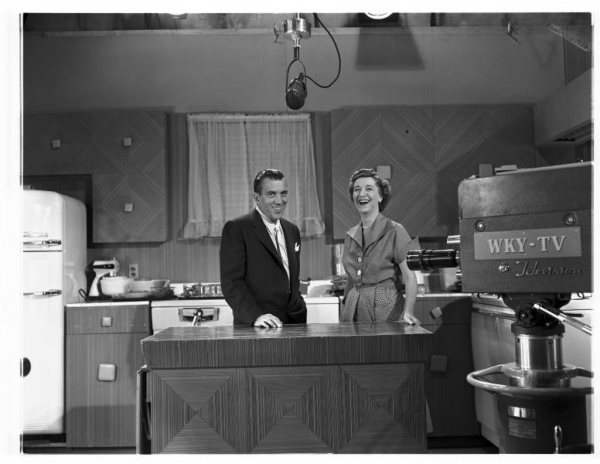
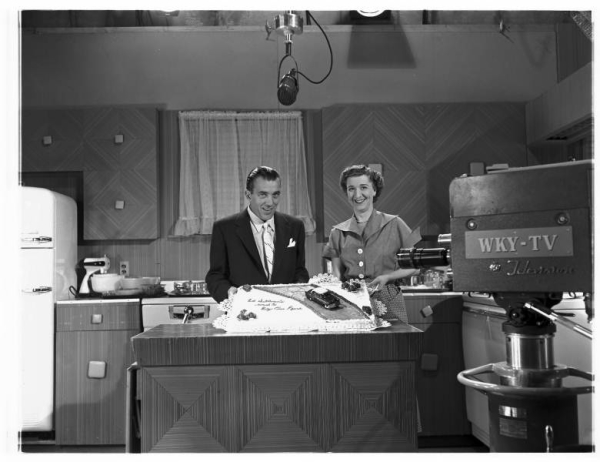


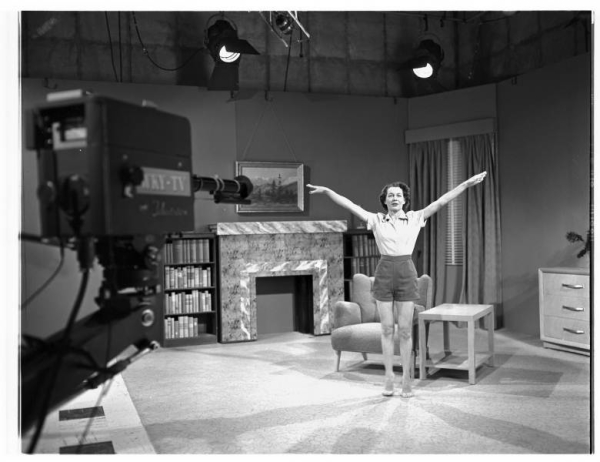
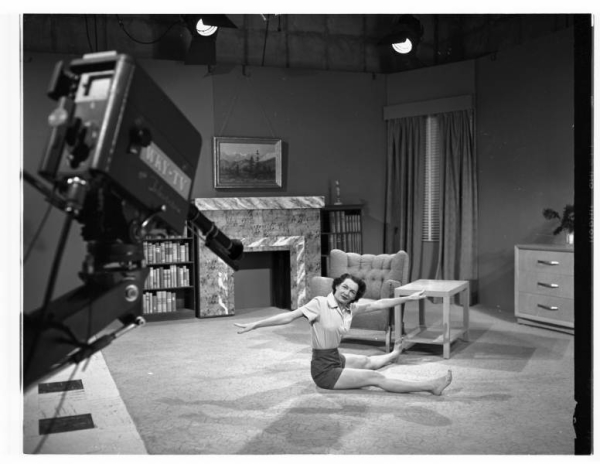
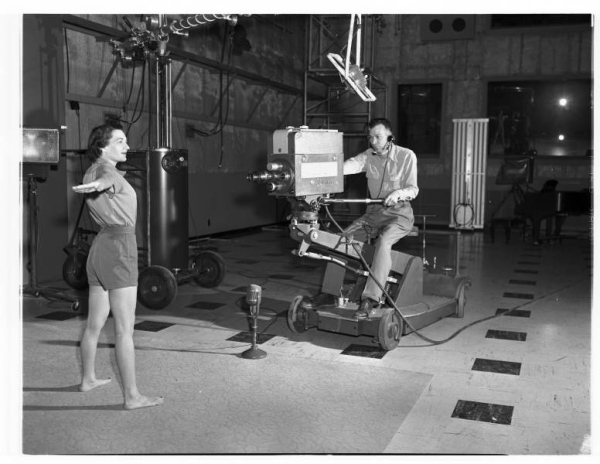
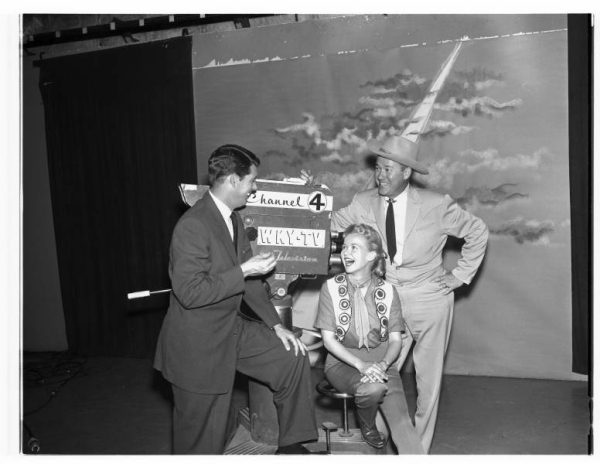
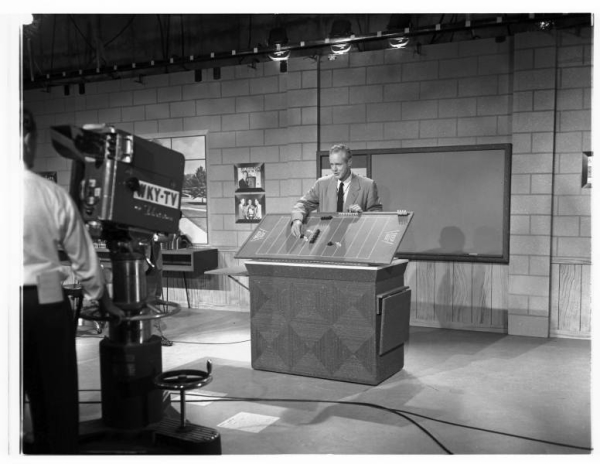

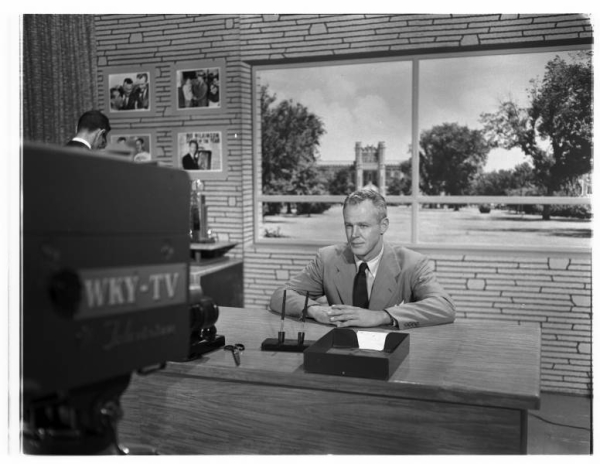
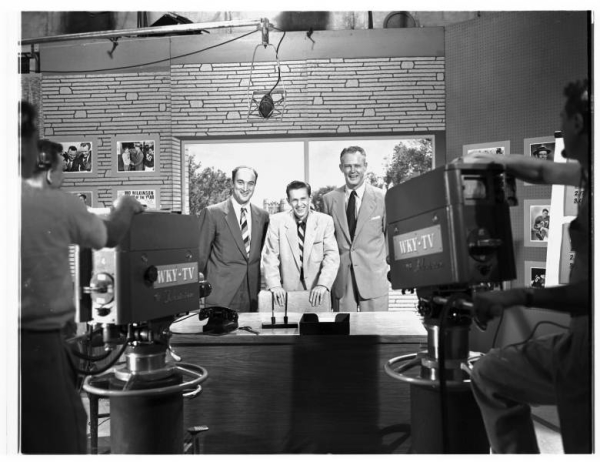
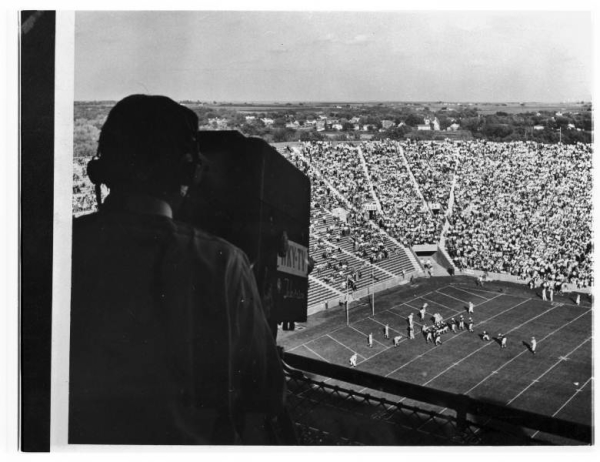
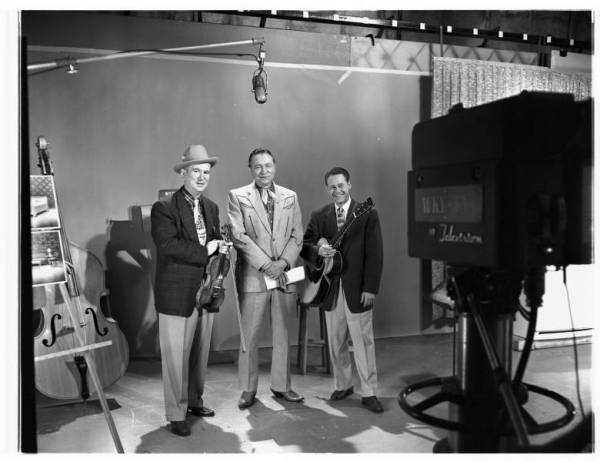


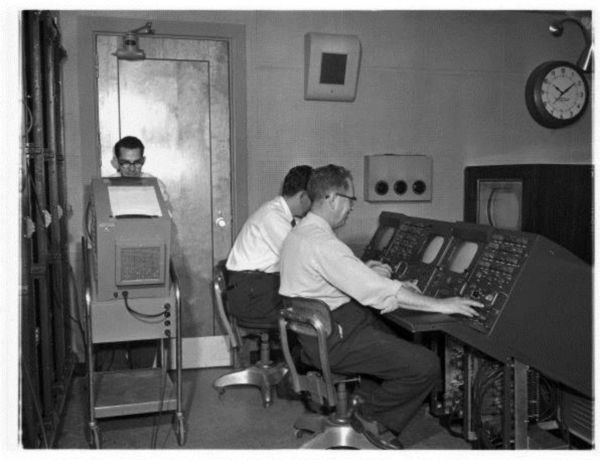

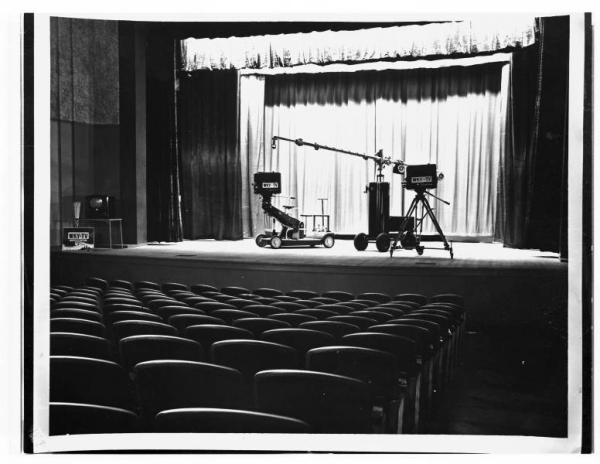

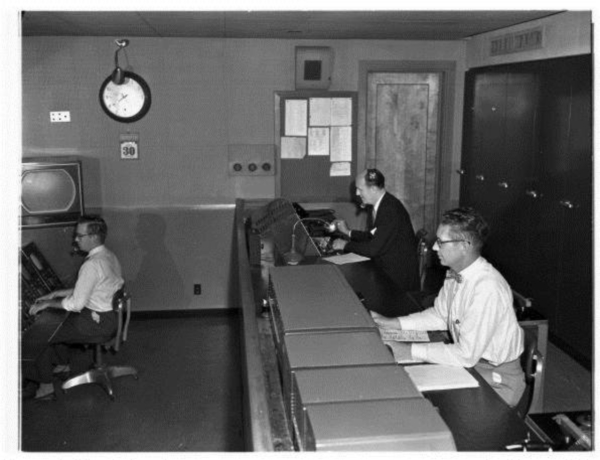


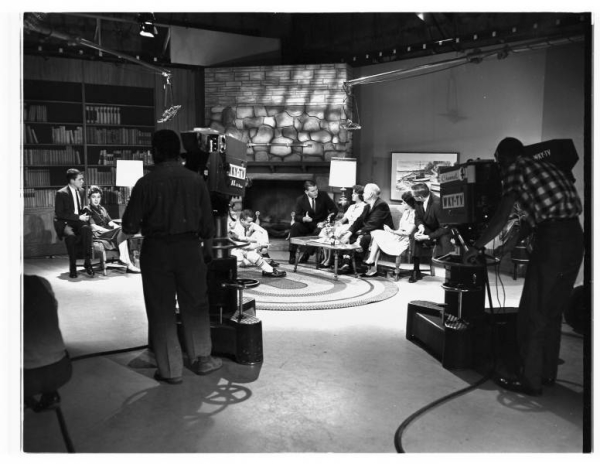

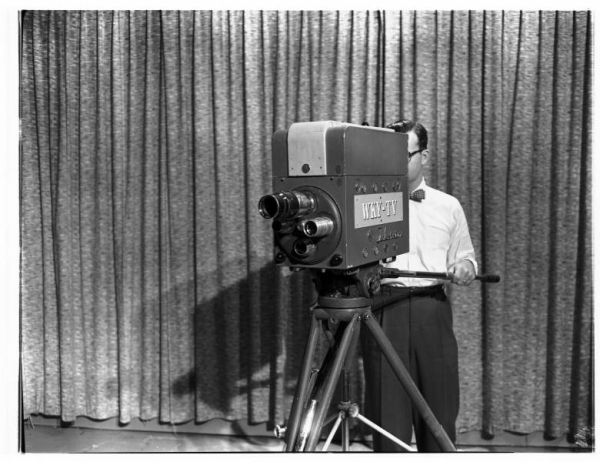
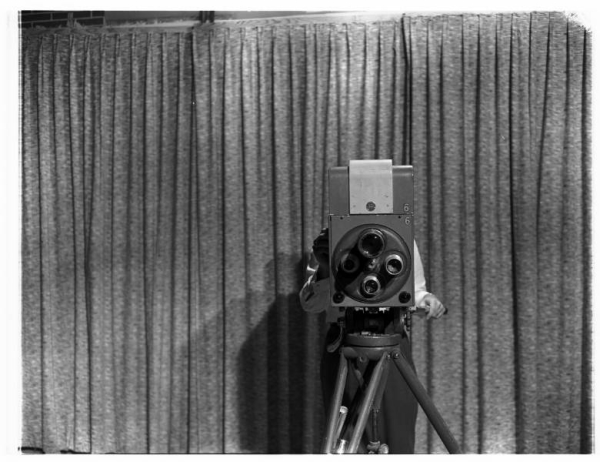
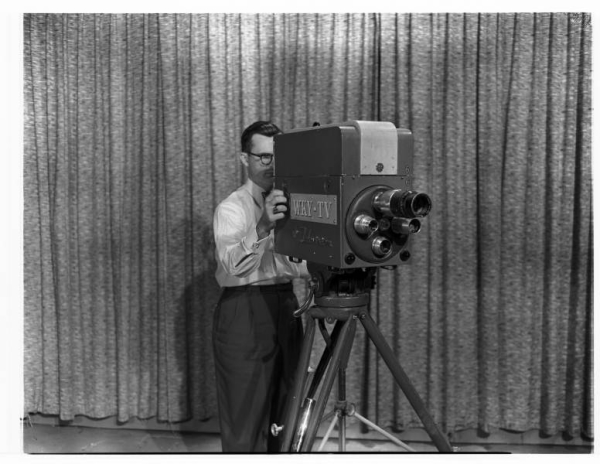
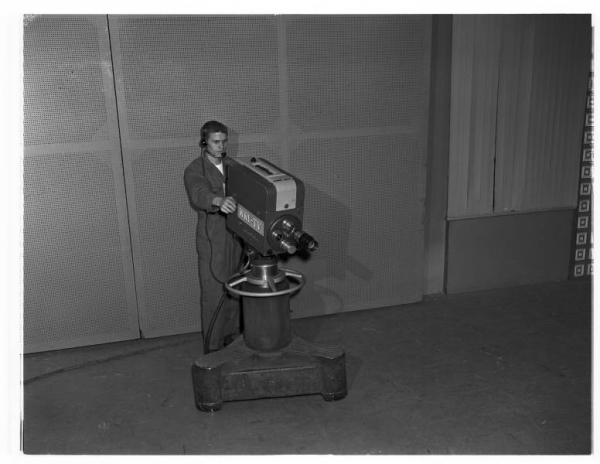

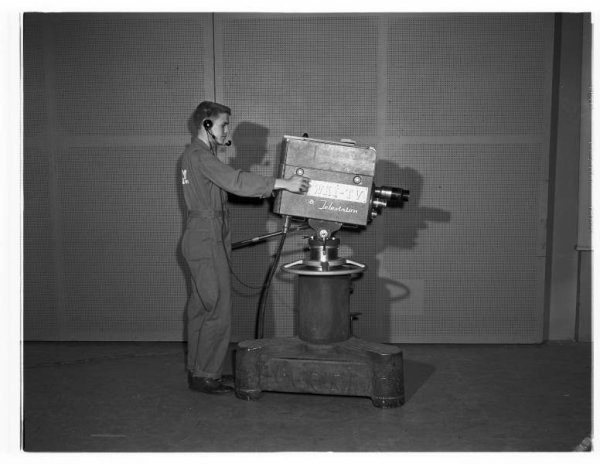
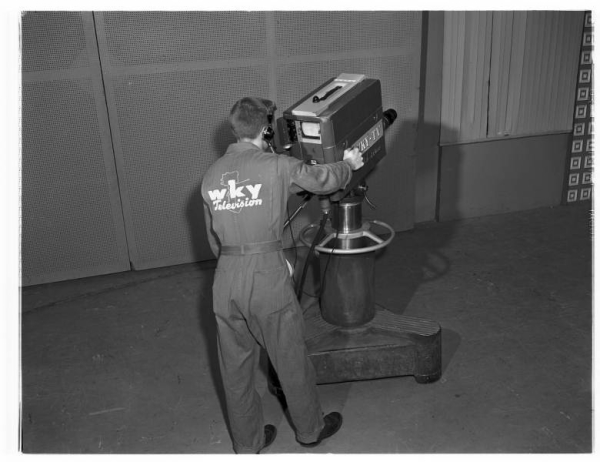
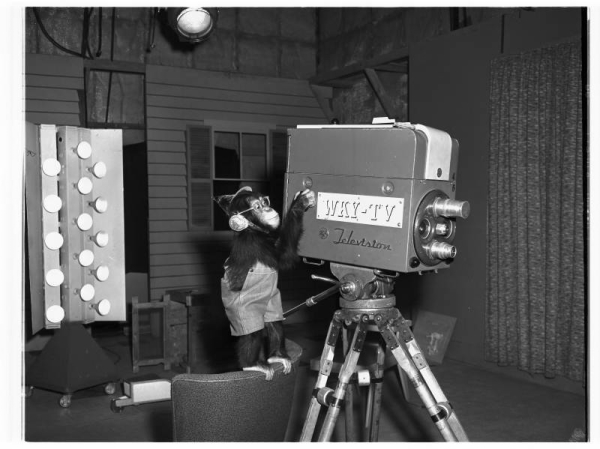
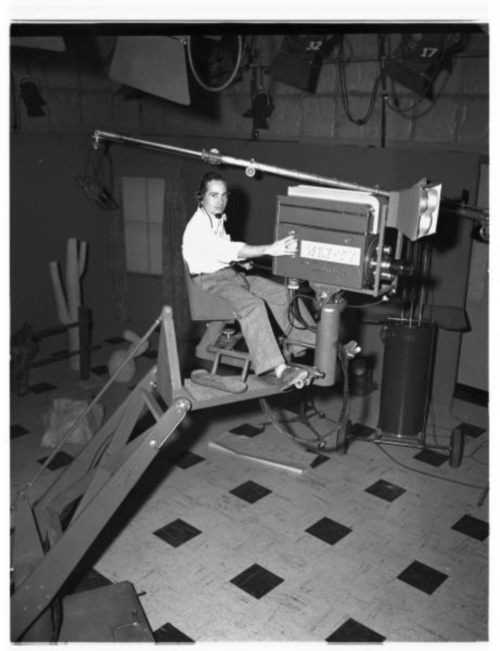
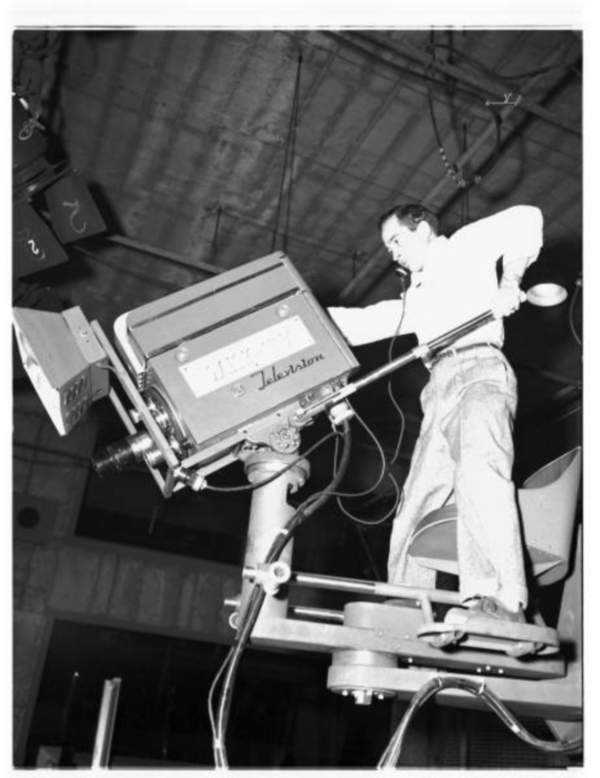
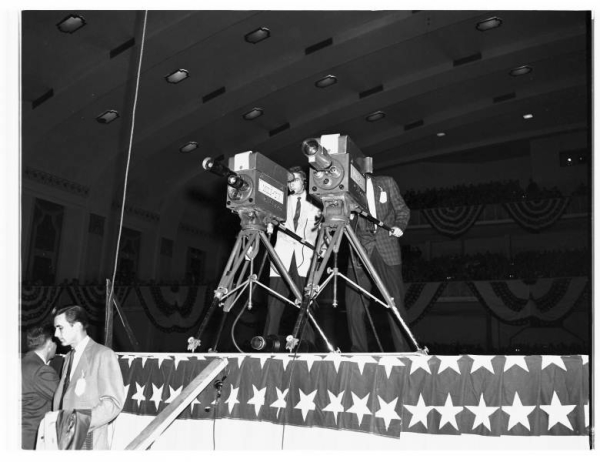
The Color Years
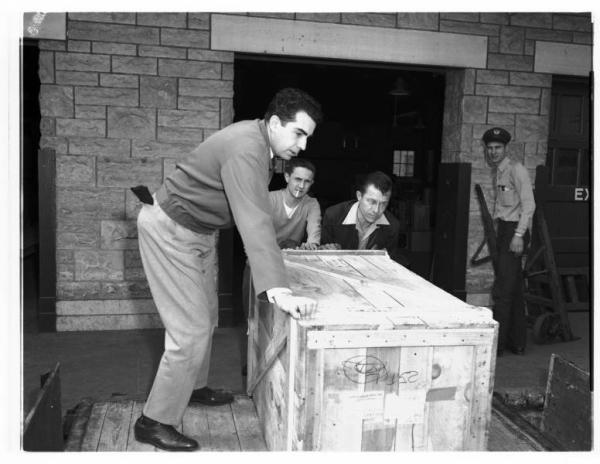
Inside this nondescript wooden crate is a revolution. Here’s how it looked when the first two RCA TK40 color cameras ever delivered to a local station were uncrated and made ready for work at WKY.
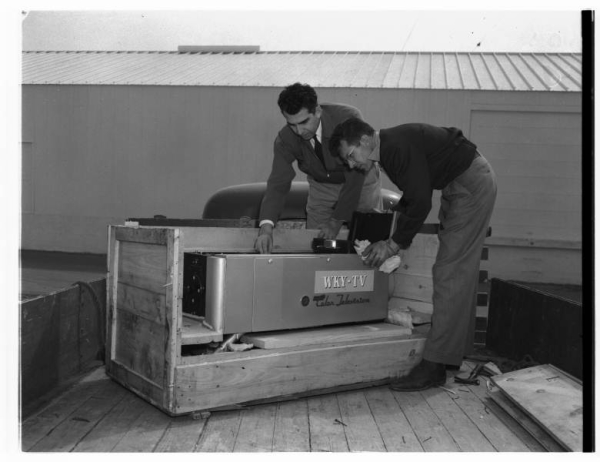
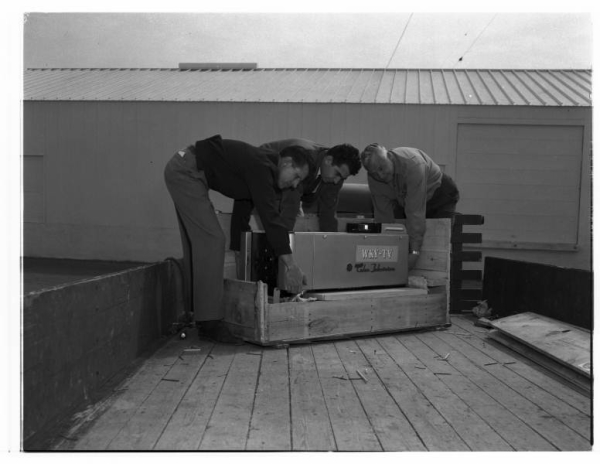
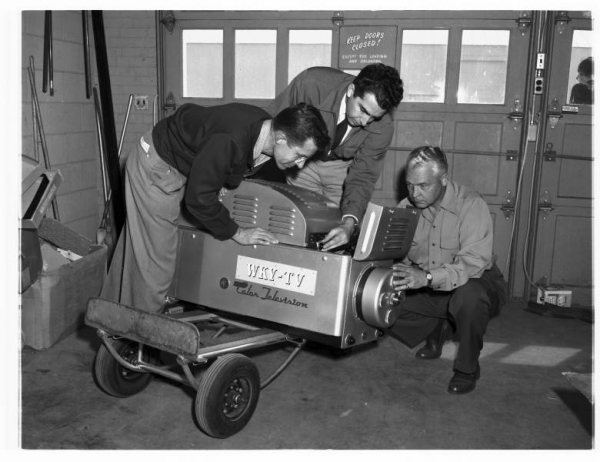
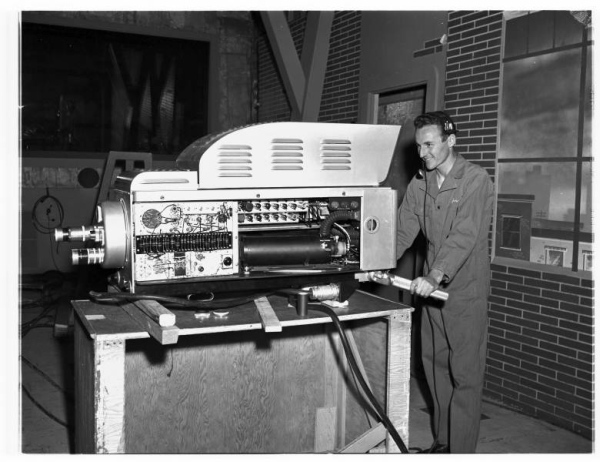

The rest, as they say, is history. Below is color television history as it happened.
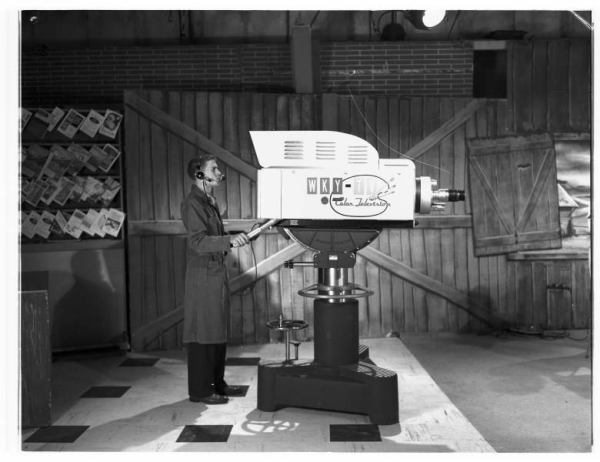

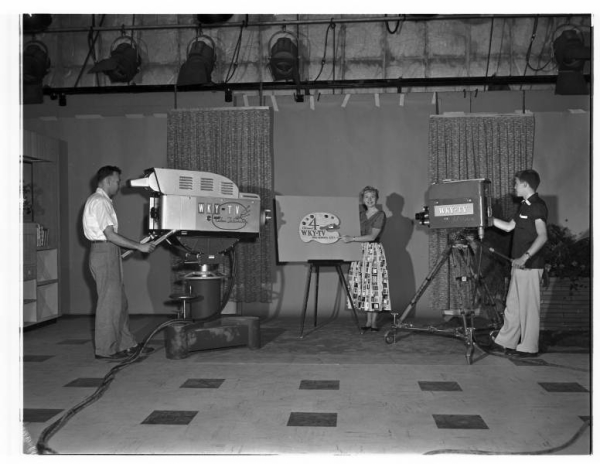

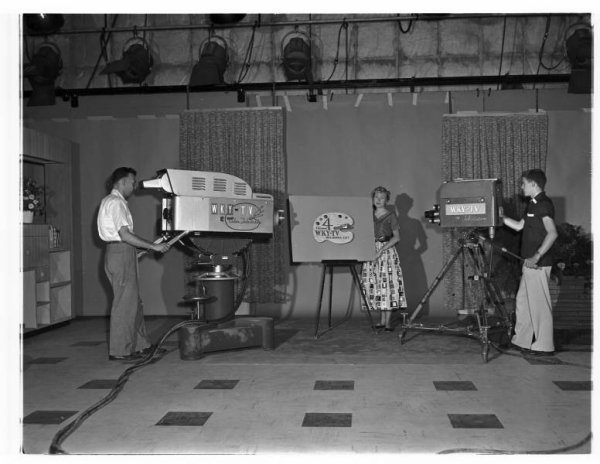
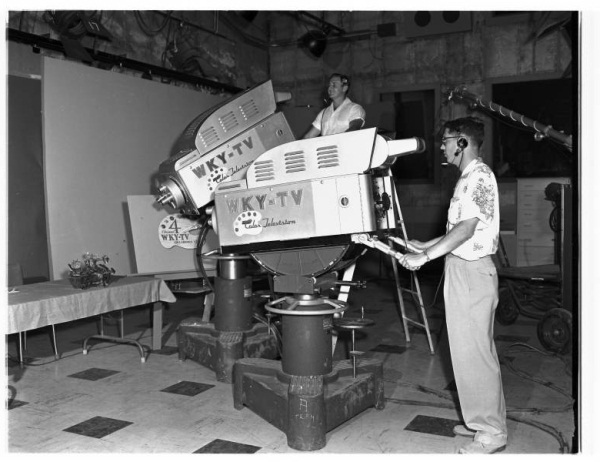
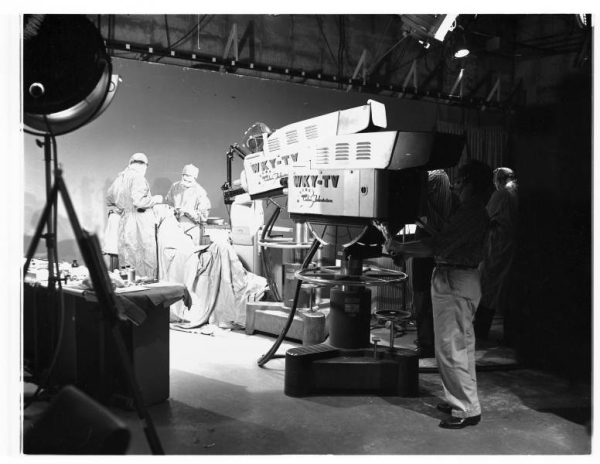

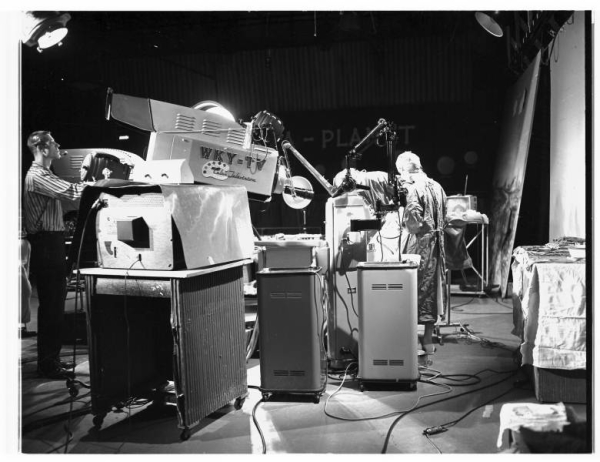


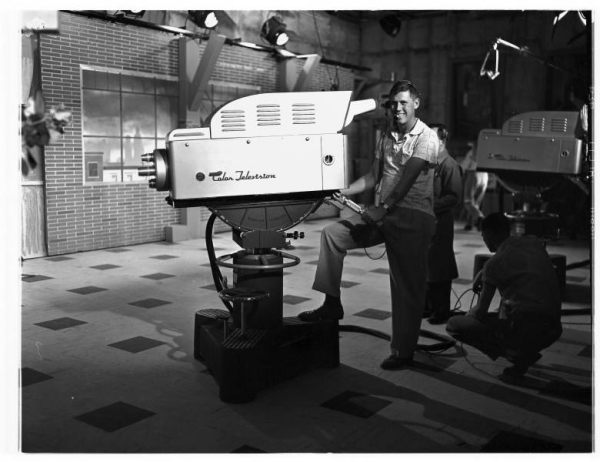
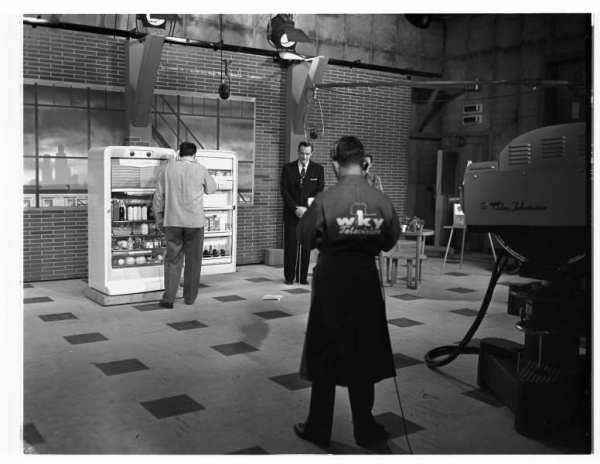
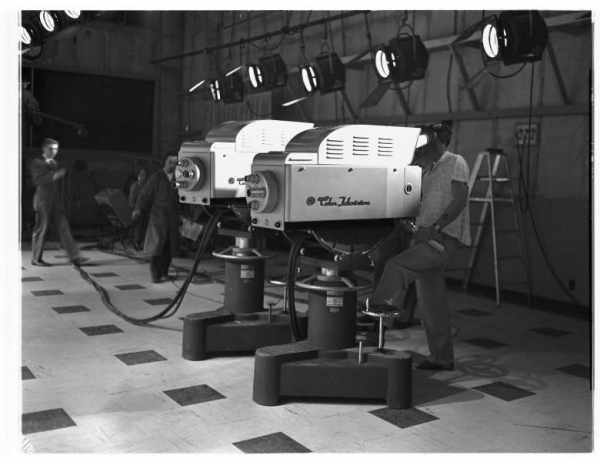
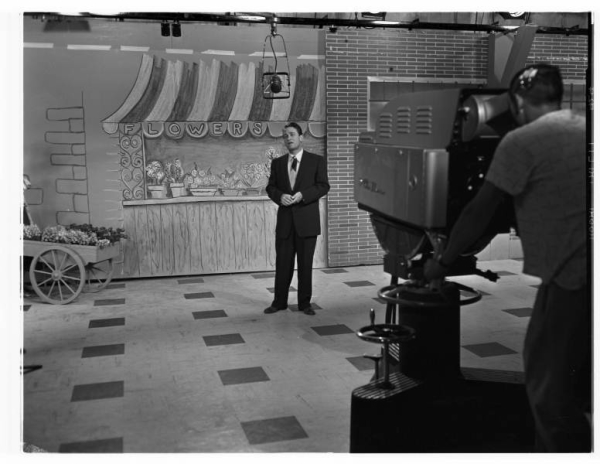

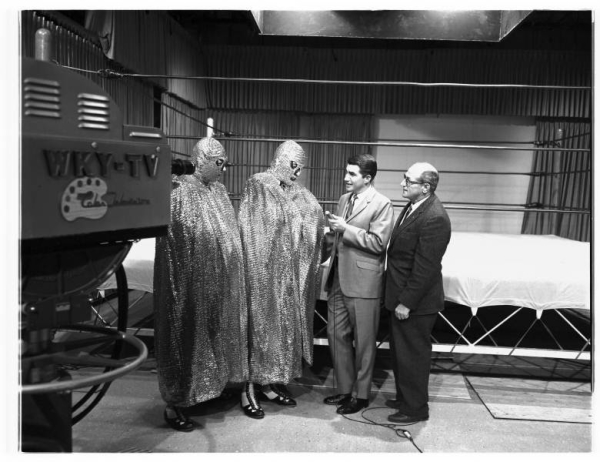
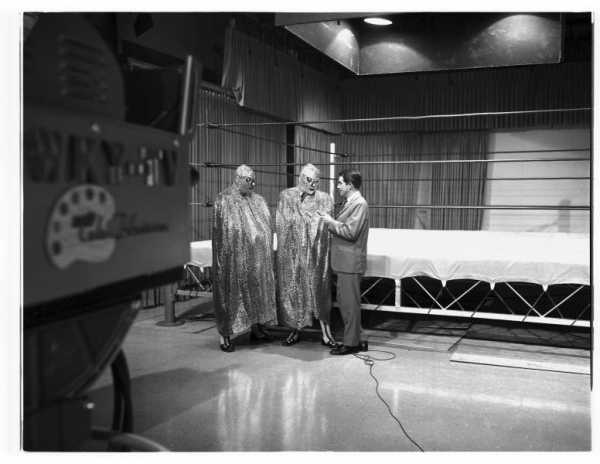



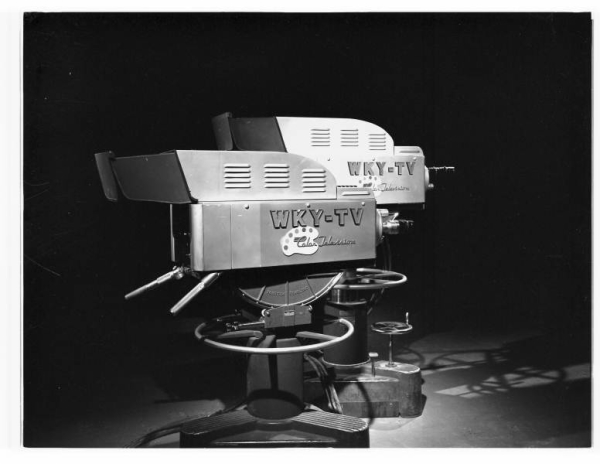
One day around Thanksgiving 2008, Lytle Hoover sent me a few photos that someone in Oklahoma City had sent to him to post on his great web site, the RCA Television Section of Old Radio.com. In those pictures (seen below) was one of these historic TK40s still in storage at KFOR (formerly WKY).
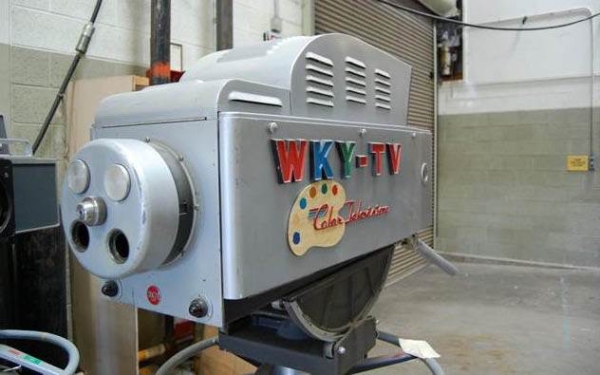
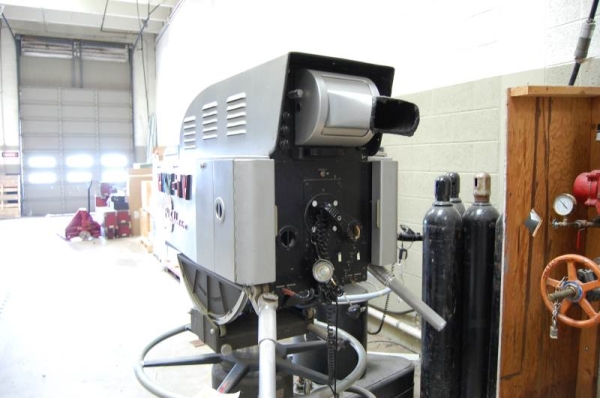

I had seen a picture of the other WKY TK40 at the Oklahoma History Center and was glad to see that at least one camera made it to safety, but I immediately became concerned that this camera might not. Unfortunately, these days broadcast properties are being bought and sold much more often than in the past, and when the accountants show up one of the first priorities is often to get rid of “the junk.” Countless cameras, pedestals, videotape machines and other early artifacts have been sent to the scrap heap with not so much as a thought as to its historical value.
I called my friends Paul Beck and Tom Sprague in Boston at the Museum of Broadcast Technology. Paul was as ecstatic and amazed as I was that this camera still existed. We talked and emailed each other for a few days about the camera, but that’s all we did…talk. That is, until I called KFOR’s general manager and asked if the station would be willing to donate it to a reputable museum, as they had with the other camera. He was open to the idea, so I immediately called Paul and let him know of the conversation.
Within a few hours, Paul called me back and sent me a copy of the letter outlining the points of the conversation he had had with the same gentleman. An agreement was in place for the camera to go to Boston. It took several months of back-and-forth communications, but in May 2009, a road trip was on the books.
In the meantime I had found out from Chuck Conrad, another camera collector in Texas, that he had an RCA TCR 100. I had called Chuck about it after seeing it on his Chalkhill Media website. I knew Tom and Paul were looking for one for the museum, so I introduced them and they were able to work out a trade that got Chuck some equipment he wanted and gave the museum the TCR 100. Below, you see the huge TCR 100 video cartridge player; below that, the monster being loaded into the truck.
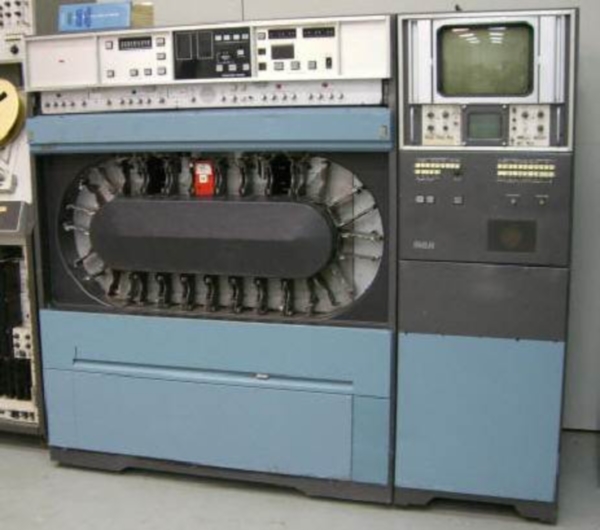

Paul and a friend, Dick Webb, flew to Oklahoma City, picked up the TK40, then drove to Chuck’s near Long View in east Texas to pick up the TCR 100. From there, they headed to Georgia and to my house. Below, you see Paul and Dick with my TK41. Paul is no stranger to the TK41, as that’s him in his early years running one at WHDH on Romper Room.
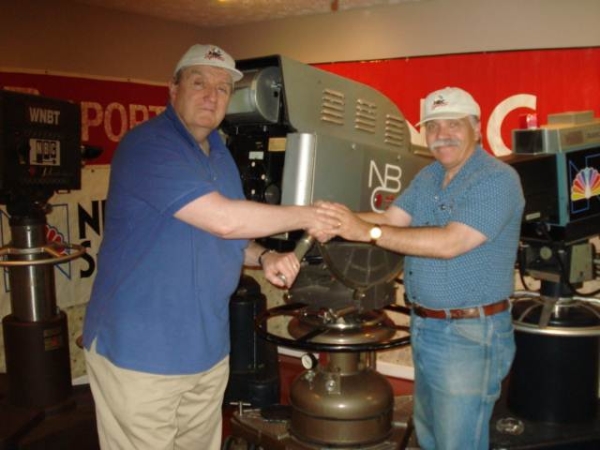

I’m sorry I didn’t get a picture of myself with Paul, but the truth is I was so excited to see him, I just forgot. Paul Beck is one-of-a-kind and I am honored to call him a friend! He is a true gentleman in every way and knows more about television and television’s history than anyone I know. After two more days on the road, Paul and Dick made it back to Boston. Below, you see the WKY TK40 at its new home with Marc Berman at the controls.


For more on the Museum of Broadcast Technology, click here or visit them at http://www.wmbt.org/
ULTRA RARE HOWDY DOODY IMAGES! The Original Howdy…
Be sure to click through these historic images, as I have made extensive comments on each of them, and each image holds a secret of its own.
These screenshots are from a rare early kinescope believed to have been shot on April 6, 1948, and would be perhaps the very first moving image of the show. The video (https://eyesofageneration.com/april-6-1948-oldest-known-howdy-doody-kinescope-footage-exclusive/) was given to us by Burt Dubrow, who was Buffalo Bob Smith’s road manager, and friend for many years. He is the ultimate expert on Howdy, and has helped all of us Doodyville fans by sharing his knowledge, and tomorrow, his footage and stories. Enjoy and share! -Bobby Ellerbee
From 1948, here is Bob Smith with “Ugly Howdy” (his name for the Paris puppet) at their homebase desk. The next shot you will see is the 8 boys and girls that came to the studio for the live show. If you were sitting where Bob is, they would be just around the corner to his left, and it would he hard for them to see him with Howdy at the desk…which was on purpose, as Bob was the voice of Howdy too. The kids could see what was happening at the desk on a monitor, but could not see that Bob was doing the Howdy voice too, which would break the illusion. Even in later years, he always had his back to the Peanut Gallery when he spoke with Howdy.
This is a very rare show intro with the original Howdy puppet. This was on film and Bob Smith would talk over this to intro the show. At the end of the intro, the live camera would find Howdy and Bob at the desk, that you will see in the next shot. At this point, the show was actually called “The Puppet Playhouse”, and although Howdy was the star, Frank Paris’s Toby Tyler puppet was also a featured player. The approximate date of these images is sometime between February of 1948, which is when Bob Keeshan was first seen as “a clown” (but not yet Clarabell), and the debut of the new Howdy which was June 8, 1948. At this point, the show was only running on Tuesday afternoons from 5 til 6. I think by June or July, the show went to half an hour, Monday – Friday.
Before there was a Peanut Gallery, there was this…two 4 seat “bucking bronco” saw horses. Before there was a Howdy Doody, there was the “Triple B Ranch” radio show on Saturday mornings on WNBC, with Bob as the host. That was a kids game show with 200 to 300 elementary schoolers in the studio as schools competed. The contestants, aged 8 – 11, four from one school, four from another sat on these very “horses” on that show, and wrong answers got them “bucked off”.
In February of ’47, Triple B Ranch debuted in a new Saturday morning children’s radio block on WNBC with Bob as host. After a few weeks on the air, the show’s writer Eddie Kean told Bob the show needed a little more comedy and, with its western theme, he asked Bob if there was a character voice he wanted to do that could be fun and match the show. Smith went into a small studio and did a couple or three voices, and when he did a kind of country bumpkin voice for a character he called Elmer, Eddie’s ears perked up when he heard what would become Elmer’s tag line…“Oh, ho, ho, howdy doody, boys and girls.” The next week, Bob added the Elmer voice to the program, letting him ask a few questions, and as always when Elmer came in and left it was always with the same line…”Oh, ho, ho, howdy doody.” To be clear, there was no budget for the show and, no puppet named Elmer…just Bob talking to himself as both host, and as Elmer.
First, about this shot…notice to Bob’s right, there is a man in a classic operatic clown suit. This is the first time we see a page named Bob Keeshan, later Clarabell and even later, Captain Kangaroo. Bobby Keeshan, as Bob called him, came to TV from radio with Smith, and at first made and held cue cards and then began handing Smith props on camera, but in street clothes. Notice Bob is in street clothes here too, but before Keeshan got the Clarabell outfit, they apparently raided the NBC wardrobe department for this costume. Now…back to our continuing story on Howdy. What happened next at the Triple B Ranch was quite interesting! After a month or so on the air, kids that came to the show began to tell Bob “they came to see Howdy Doody, and were disappointed he had not been there.” When Bob, his producer Jim Gaines and Eddie Kean understood that the kids were thinking Elmer’s name was Howdy Doody, they decided they needed to not only change Elmer’s name, but if kids wanted to see him, why not talk to the television people. And they did. Roger Muir, who was a producer and director at NBC, had only been with the company for six months, but almost from the first week, he began a conversation with the man who hired him about the need for some kids television on the network. That man was Warren Wade, the head of programming. One day, Wade met Muir in a hallway and as they were passing, Wade called out to Muir, “Your wish has come true!” “What do you mean” asked Muir. “We are going to start a kid’s show and you are driving the boat!”
Here is another rare shot of Keeshan in the classic clown costume and in full makeup, but not his Clarabell face. By the way, Smith sang live on the show, and this was the only show on TV during a long and hard Musicians strike, with live music. Seem the AFM did not count a ukulele as an instrument covered in the contract. Back to Howdy. There wasn’t time to make a Howdy puppet for the first show (Dec. 27, 1947), and after Bob was invited in permanently as the host, they would have to make one. It took three weeks before Howdy made an appearance, but Howdy was there…hiding in a desk drawer, too bashful to come out and play, with Bob providing the voice. Did they did sing the Howdy Doody song on the first show? No, but according to Eddie Kean, they did on the second show. Eddie Kean took the public domain song, “Tra La La Boom De Ay” and put the now famous words to it and taught it to the kids just before the show started at 5 PM. The third week when he went to teach the kids the song, some of them already knew it, and that was a good omen. There couldn’t have been a better day for the premier of “Puppet Playhouse”. It was just after Christmas with lots of new TV sets in use, and outside, one of the worst snowstorms in years had hit the northeast, which gave them a captive audience. Inside NBC’s only television studio, 3H, it was hot and everyone had a headache. It wasn’t until April of 1948 that the new RCA TK30 Image Orthicon cameras were installed in 3H. The TK30s required less than a tenth of the 1200 foot-candles of light the old Iconoscope cameras required, and those lights were hot! Not being used to the bright television lights, Smith’s head was throbbing and the puppeteers were 10 feet off the floor and in the hottest part of the studio…they were soaking wet with sweat. The first show ended with aspirins for all.
This is the original Howdy Doody puppet, created by Frank Paris. The puppet Paris came up with was based mostly on the way Howdy sounded. Remember, the original character’s name was Elmer, and I don’t think Paris could shake that notion when he designed this unit. Bob Smith never liked this Howdy and always referred to the original as “Ugly Doody”, once the new one had arrived. In fairness, all Paris had to go on was the sound, and what he had heard Howdy do on the “Triple B Ranch.” Even Bob had not yet fully developed Howdy’s character or fleshed out what his general demeanor would be. It was all so new and happening so fast. To get rid of “Ugly Howdy”, his run for President was used as an excuse for him to go on the campaign trail for several weeks. To keep sponsors happy, and Howdy in the mix, he did reports on the phone, and in early June of ’48 returned with bandages over his face. The new Howdy was unbandaged on June 8 and revealed the red headed freckle face boy that became an icon. Howdy’s voice and demeanor changed too, to a lighter level. By the way, the reason Howdy wanted to have the plastic surgery on his face was to look as good as his handsome rival for President, Mr. X, who was later revealed to be Howdy’s twin brother Double Doody. The Double Doody puppet arrived some months later and was actually a backup puppet. Both new Howdy puppets were created by Velma Wayne Dawson, and were based on drawing from two friends of the show that worked for Disney…Mel Shaw and Robert Allen.
“Legend Has It”…The Fence Between Networks At Super Bowl 1
“Legend Has It”…The Fence Between Networks At Super Bowl 1
Many of us have heard about the fence that had to be built between the CBS and NBC crews covering this event, but finally, here is the only photo proof that it happened.
http://articles.chicagotribune.com/1986-01-26/sports/8601070170_1_nbc-sports-pat-summerall-super-bowl
From the Chicago Tribune, here is the story as it was reported back in the day. FYI, CBS crews covered the game action, and used Norelco PC70s, which NBC carried, in the first and last simulcast of a Super Bowl. At the time NBC was near the start of their use of PC70s on their sports trucks too. Enjoy! -Bobby Ellerbee